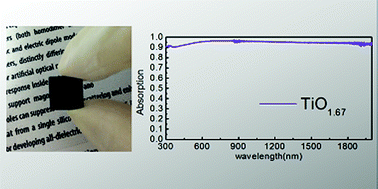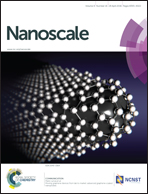Plasmonic near-touching titanium oxide nanoparticles to realize solar energy harvesting and effective local heating†
Abstract
Through the excitation of plasmon resonance, the energy of plasmonic nanoparticles either reradiates through light scattering or decays into energetic electrons (absorption). The plasmon-induced absorption can greatly enhance the efficiency of solar energy harvesting, local heating, photodetection and photocatalysis. Here, we demonstrate that heavily self-doped titanium oxide nanoparticles (TiO1.67 analogue arising from oxygen vacancies in rutile TiO2) with the plasmon resonance dominated by an interband transition shows strong absorption to build a broadband perfect absorber in the wavelength range from 300 to 2000 nm covering the solar irradiation spectrum completely. The absorptivity of the fabricated array is greater than 90% in the whole spectral range. And the broadband and strong absorption is due to the plasmon hybridization and hot spot generation from near-touching TiO1.67 nanoparticles with different sizes. What is more, the local heating of a TiO1.67 nanoparticle layer is fast and effective. The temperature increases quickly from 30 °C to 80 °C within 200 seconds. This local heating can realize rapid solar-enabled evaporation which can find applications in large-scale distillation and seawater desalination. These findings actually open a pathway for applications of these newly developed plasmonic materials in the energy and environment fields.


 Please wait while we load your content...
Please wait while we load your content...